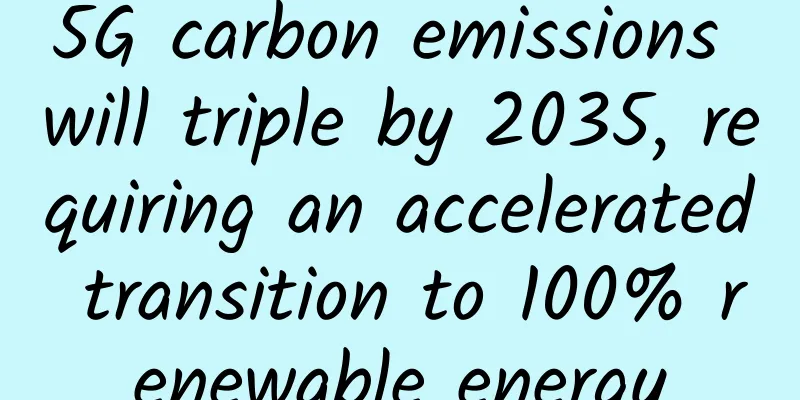5G carbon emissions will triple by 2035, requiring an accelerated transition to 100% renewable energy

|
On May 28, the Metrology and Testing Center of the Fifth Institute of Electronics of the Ministry of Industry and Information Technology (Guangzhou CESI Metrology and Testing Center) released the report "China's Digital Infrastructure Decarbonization Road: Data Center and 5G Carbon Reduction Potential and Challenges (2020-2035)" (hereinafter referred to as the "Report"), predicting the energy consumption and carbon emission trends of China's digital infrastructure such as data centers and 5G.
The report points out that after China fully achieves its carbon peak in 2030, carbon emissions from digital infrastructure will continue to grow, and has become a new growth point for energy consumption and carbon emissions. It is necessary to accelerate the transition to 100% renewable energy and achieve carbon neutrality as soon as possible. The report predicts that by 2035, China's total electricity consumption for data centers and 5G will be about 2.5-3 times that of 2020, reaching 695.1-782 billion kWh, accounting for 5-7% of China's total electricity consumption. At the same time, the total carbon emissions from China's data centers and 5G will reach 230-310 million tons in 2035, accounting for about 2-4% of China's carbon emissions, equivalent to the current carbon dioxide emissions of two Beijing cities. Among them, the carbon emissions of data centers will increase by up to 103% compared with 2020, and the carbon emissions of 5G will increase by up to 321%. In contrast, key emission industries such as steel, building materials, and non-ferrous metals are expected to peak their carbon emissions and begin to decline around 2025. The "lock-in effect" of carbon emissions from digital infrastructure will become an important challenge for China to achieve carbon peak and further carbon neutrality. The report suggests that accelerating the transition to 100% renewable energy can fundamentally help the digital infrastructure industry reduce carbon emissions and is the priority path for the industry to move toward carbon neutrality. Data centers and 5G can apply renewable energy by investing in distributed and centralized renewable energy projects, purchasing renewable energy from the market, and subscribing to green electricity certificates, while exploring application scenarios combining energy storage with renewable energy. To this end, the "Report" makes the following recommendations to relevant companies: First, set a goal of achieving 100% renewable energy by 2030, and further propose a full-scope (scope 1, 2, 3) carbon neutrality goal by 2030; second, expand the scale of corporate renewable energy procurement, actively communicate with key stakeholders, and help further breakthroughs in market-oriented renewable energy procurement mechanisms; third, further enhance energy information disclosure, and disclose greenhouse gas emissions and energy consumption information. |
>>: Wi-Fi 6 is just being used, and Wi-Fi 7 from the three major players is already on the way
Recommend
Today, China’s 5G is two years old!
On October 31, 2019, the first day of the 28th Ch...
5G packages in various countries are ridiculously expensive! How is 5G priced in my country?
In 2019, 5G communication technology gradually be...
AlphaVPS: 1TB large hard drive VPS monthly payment starts from 5 euros, AMD EYPC+NVMe series monthly payment starts from 3.99 euros
AlphaVPS is a foreign hosting company founded in ...
Which collaboration metrics determine the business value of an application?
The criteria for evaluating the business value of...
Huawei and iSoftStone jointly launch IoT solutions to lead the digital transformation of the industry
[51CTO.com original article] The implementation o...
Core technologies for building 5G networks: the differences and connections between SDN and NFV
We often hear network operators and equipment ven...
Hizakura: €17.99/year-AMD Ryzen7950x/1GB/15GB/4TB/Netherlands data center
The tribe once shared information about Hizakura,...
What is SSH? A detailed explanation of the principle is enough to read this article!
SSH (Secure Shell) is a network security protocol...
RackNerd: AMD Ryzen packages are available, starting at $18.88 per year for 1GB memory packages, San Jose/New York data centers
RackNerd has launched various AMD Ryzen series da...
5G spreads the new coronavirus? Foreigners took it for granted and many 5G base stations were burned down
According to foreign media reports, recent conspi...
5 false truths about 5G mobile phones, don't be fooled anymore
[[360004]] Although some things are real, they ar...
RAKsmart: Bare metal servers in the US/Japan/Hong Kong starting from $49/month, 35% off for first order of bare metal cloud/VPS/cloud server for new users
RAKsmart has some new changes in this month's...
RAKsmart Bare Metal Cloud/Cloud Server/VPS 30% off, Dedicated Server Limited Flash Sale Starting from $30/month
Coinciding with the Chinese New Year, RAKsmart ha...
Network Analysis in Rust: Capturing and Analyzing Network Traffic with Pcap and Pnet
Network analysis is critical for monitoring, secu...
Ruijie's all-scenario cloud desktop leads the new trend of Internet medical development
At present, affected by the epidemic, Internet me...








![[11.11] Hostons: AMD Ryzen+NVMe series VPS 50% off starting at $2/month, multiple data centers in Los Angeles/Salt Lake City/Portland, etc.](/upload/images/67cabd0fb889e.webp)
